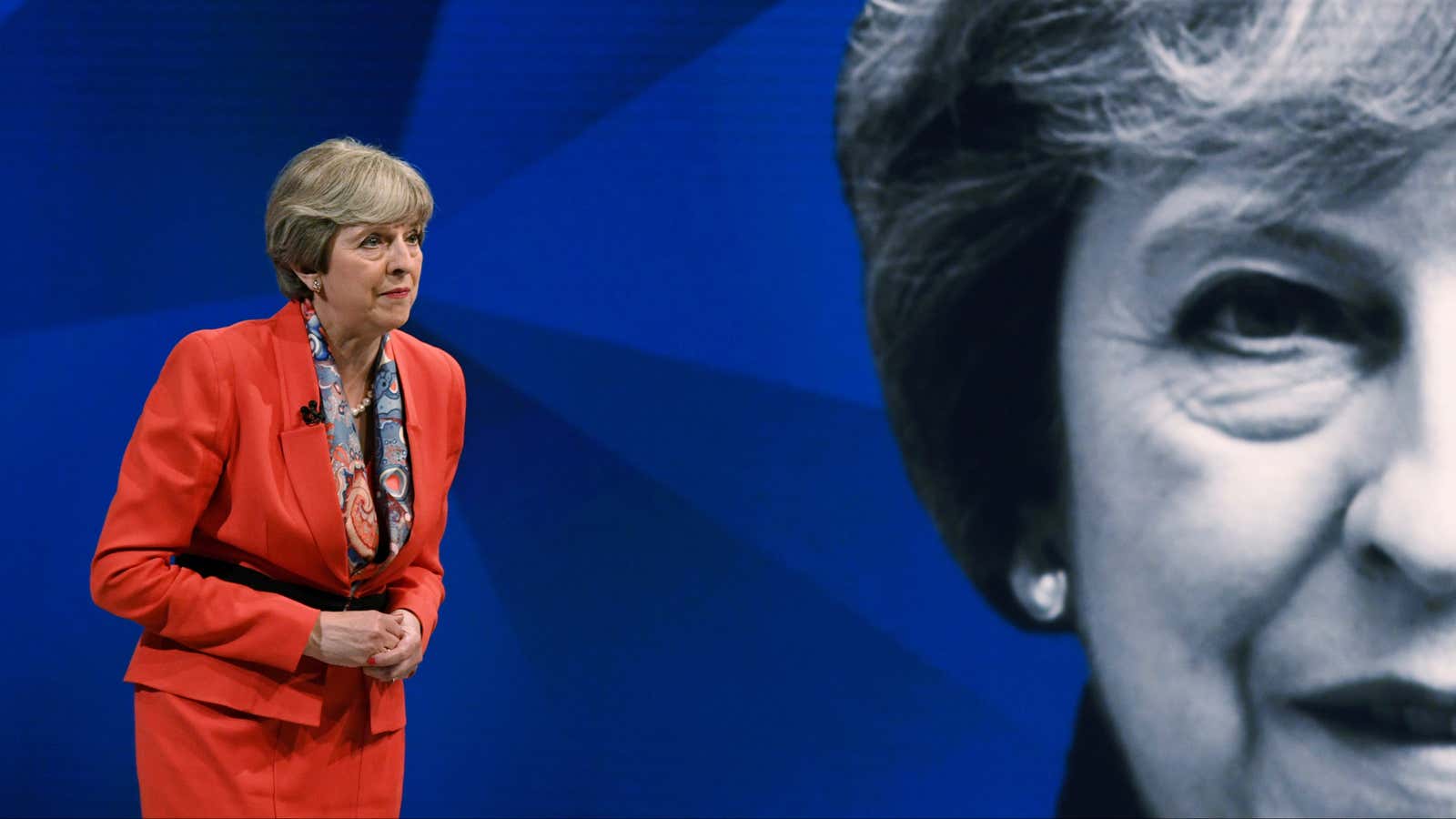In mid-April, in the aftermath of the vote for Brexit that pushed her into power, British prime minister Theresa May and her Conservative Party enjoyed a 20-point lead over the Labour Party. Confident of her party’s unassailability, May called a snap election.
Her gamble: the Conservatives would secure more seats in Parliament, silencing critics both inside and outside her party and allowing May to emerge with a stronger hand to negotiate Brexit. That gamble backfired.
The Conservatives’ advantage has shrunk to between one and 12 points, depending on the poll. Even if she does triumph in the election, she may not increase her party’s majority in Parliament at all. There’s now the very real possibility of a hung parliament where no party has power, or even handing over leadership of the country to Labour’s Jeremy Corbyn, a socialist who very recently had little support inside his own party and much less beyond.
May seems to have weakened her own hand. How, exactly, did she blow such a big lead?
Bad political decisions
If social security is the third rail of US politics, social care is much the same in Britain: you don’t mess with old people because old people vote. (A survey of voters post-Brexit determined that 64% of registered voters aged 18-24 cast votes, compared to 90% of over-65s.)
And yet when May launched her party’s manifesto, she announced a plan to make wealthier elderly people pay for more of their own care. (Much of it is currently covered by the state.) It was instantly dubbed a “dementia tax” by her opponents, and appeared to shock people inside her own party. Within days, May backtracked, leading one British journalist to quip it was “the first time in modern history that a party’s actually broken a manifesto policy before the election.”
The social care U-turn was not her first. The Financial Times highlighted nine policy turnarounds (paywall), including promises not to call a snap election, an announcement to raise national insurance contributions—which she quickly reversed—and Brexit itself. May was a “Remainer” until the country voted to leave the European Union, at which point she took up the slogan, “Brexit means Brexit.”
There have also been three terror attacks in Britain since March. Before becoming prime minister, May was home secretary, in charge of the security of the country. She oversaw cuts to the police force of 19,500 in England and Wales between 2010 and 2016, prompting critics to say she left the UK vulnerable. Steve Hilton, a former adviser to Conservative prime minister David Cameron, even called on her to resign.
Personality counts
May has sold herself to the public as a “strong and steady” leader in a tightly scripted campaign, much like Hillary Clinton packaged herself as the experienced and sensible candidate who had enough briefing books to fill a library. But steady and sensible has not been a slam-dunk strategy for elections recently (see: Brexit; Trump, Donald).
Her decision to call an election meant five weeks—an eternity in politics—under the strobe lights of the press and public, revealing a candidate who does not answer questions, who maniacally sticks to script. She has repeated her “strong and steady” mantra so often that a veteran Labour MP once asked May whether a microchip had been implanted in her brain forcing her to say “strong and stable” every 18 seconds.
One local journalist in Plymouth spent five minutes with her and concluded there was not a single quote worth using (which he coyly used in a piece about how she said nothing). In the social-media age, the campaign’s overly scripted and highly managed approach comes off as inauthentic and a bit paranoid—another similarity to Clinton, who was hyper-sensitive about press compared to her Twitter-wielding opponent.
May made the election all about her style of leadership. But her style has proven to be not so likable.
Don’t underestimate your rival
Not long ago, one Labour candidate said of Corbyn (paywall): “He’s an unelectable, incompetent extremist. This election could be absolute carnage.” Since the election started, Corbyn enjoyed a unforeseen resurgence, bolstered by a left-wing platform that includes nationalization of the railways, massive tax increases on the rich, and more money for everyone under the sun.
Corbyn “has exceeded expectations—but very, very low expectations,” Will Walden, Boris Johnson’s former communications director who is now at PR firm Edelman UK, tells Quartz. “It was never a 20-point election. The polls were likely to narrow.”
In contrast to her wooden and repetitive appearances, Corbyn has seemed at ease, especially in the face of Conservative mud-slinging. May recently said Corbyn would be “naked in the negotiating chamber” if he were to lead Brexit talks; Corbyn responded, “I think it’s totally inappropriate to describe anyone as naked. Even me.”
May has not helped herself by refusing to debate Corbyn, who then accused her of “dodging” a head-to-head showdown. On May 31, Corbyn made a canny last-minute decision to participate in what turned out to be a scrappy seven-way debate on BBC, meaning that May was the only leader of a major political party who did not turn up. The Conservatives spent most of the debate being bashed on national television.
Corbyn supporters argue (paywall) that something has fundamentally changed: crowds at his rallies are bigger, younger people are mobilized, and May has underperformed. They feel this could be their chance to seize power. Corbyn has significantly more appeal among younger voters, and has been far savvier in using social media (paywall) to mobilize potential voters.
The question is whether they decide to vote.
